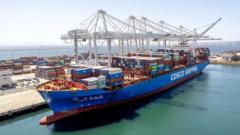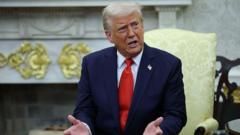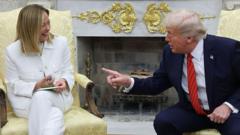U.S. chip manufacturing has lagged behind Asia, leading to skepticism about Trump's strategies to boost this sector. While tariffs and incentives aim to revitalize American production, challenges such as skilled labor shortages and complex global supply chains remain.
The Challenges of Trump's Semiconductor Strategy

The Challenges of Trump's Semiconductor Strategy
As the U.S. enters a chip manufacturing race, questions arise over the viability of Trump's approach amidst America's industrial shortcomings.
In 2021, former U.S. Commerce Secretary Gina Raimondo highlighted the consequences of America's waning position in chip manufacturing. Fast forward four years, and the semiconductor race is still a focal point in the U.S.-China tech rivalry. President Donald Trump has positioned himself as a champion of reviving U.S. chip production, asserting that his tariff policies will rejuvenate the American economy and bring jobs back home. However, the reality is far more intricate. Major firms have faced obstacles like a lack of skilled workers and variable quality in domestic factories.
The manufacturing process of semiconductors, which power a vast array of devices from smartphones to military aircraft, involves numerous complex steps. Initially developed in the U.S., the actual production of high-precision chips has significantly shifted to Asia, with Taiwan, South Korea, and Japan at the forefront. For instance, an iPhone’s chips are often designed in the U.S. but made in Taiwan or Japan and later processed in multiple countries before reaching American consumers.
Trump's approach includes threats to impose heavy tariffs on companies like Taiwan Semiconductor Manufacturing Company (TSMC) unless they open factories on U.S. soil. Yet, industry experts contend that the multifaceted nature of semiconductor production requires long-term planning and substantial investment, transcending Trump's administration. While certain firms have been willing to invest in the U.S., challenges abound, including recruitment issues and rising construction costs.
Additionally, U.S. legislation like the Chips and Science Act, enacted under President Biden, aimed to encourage domestic chip production through grants and incentives for companies willing to invest in local factories. TSMC and Samsung have been key beneficiaries of these measures, announcing significant investments in their U.S. facilities.
Despite these efforts, experts warn the U.S. is still trailing behind Taiwan in chip manufacturing capabilities. The foundational advantages Taiwan has built over decades cannot be replicated overnight, especially in light of immigration policies that restrict skilled labor from entering the U.S. The current restrictions pose a significant bottleneck, impacting the ability to train the necessary workforce for advanced chipmaking.
As global competition in semiconductor technology intensifies, countries like India are expressing potential to emerge as new manufacturing hubs. India could integrate into the chip supply chain more effectively than the U.S. due to its geographic position, lower labor costs, and relatively strong educational infrastructure. Nevertheless, it too faces hurdles, including securing land for factories and accessing quality water essential for chip production.
U.S. companies heavily depend on the continuous supply of chips, creating pressure on Trump’s administration to reconsider tariff strategies. Lobbying efforts from influential figures like Apple CEO Tim Cook suggest that flexibility might be key to navigate the semiconductor landscape. Past instances of Trump lifting bans and altering tariffs highlight the ongoing negotiations within the chip industry.
Ultimately, industry insiders argue that while the U.S. can build a robust chip manufacturing sector, substantial investment backed by collaborative global ties will be fundamental to reach advanced fabrication capabilities at scale. Trump’s isolationist approach contrasts with the global partnerships that have historically enabled the semiconductor industry to thrive, emphasizing that a successful path forward may rely on embracing international collaboration rather than placing barriers on trade.
The manufacturing process of semiconductors, which power a vast array of devices from smartphones to military aircraft, involves numerous complex steps. Initially developed in the U.S., the actual production of high-precision chips has significantly shifted to Asia, with Taiwan, South Korea, and Japan at the forefront. For instance, an iPhone’s chips are often designed in the U.S. but made in Taiwan or Japan and later processed in multiple countries before reaching American consumers.
Trump's approach includes threats to impose heavy tariffs on companies like Taiwan Semiconductor Manufacturing Company (TSMC) unless they open factories on U.S. soil. Yet, industry experts contend that the multifaceted nature of semiconductor production requires long-term planning and substantial investment, transcending Trump's administration. While certain firms have been willing to invest in the U.S., challenges abound, including recruitment issues and rising construction costs.
Additionally, U.S. legislation like the Chips and Science Act, enacted under President Biden, aimed to encourage domestic chip production through grants and incentives for companies willing to invest in local factories. TSMC and Samsung have been key beneficiaries of these measures, announcing significant investments in their U.S. facilities.
Despite these efforts, experts warn the U.S. is still trailing behind Taiwan in chip manufacturing capabilities. The foundational advantages Taiwan has built over decades cannot be replicated overnight, especially in light of immigration policies that restrict skilled labor from entering the U.S. The current restrictions pose a significant bottleneck, impacting the ability to train the necessary workforce for advanced chipmaking.
As global competition in semiconductor technology intensifies, countries like India are expressing potential to emerge as new manufacturing hubs. India could integrate into the chip supply chain more effectively than the U.S. due to its geographic position, lower labor costs, and relatively strong educational infrastructure. Nevertheless, it too faces hurdles, including securing land for factories and accessing quality water essential for chip production.
U.S. companies heavily depend on the continuous supply of chips, creating pressure on Trump’s administration to reconsider tariff strategies. Lobbying efforts from influential figures like Apple CEO Tim Cook suggest that flexibility might be key to navigate the semiconductor landscape. Past instances of Trump lifting bans and altering tariffs highlight the ongoing negotiations within the chip industry.
Ultimately, industry insiders argue that while the U.S. can build a robust chip manufacturing sector, substantial investment backed by collaborative global ties will be fundamental to reach advanced fabrication capabilities at scale. Trump’s isolationist approach contrasts with the global partnerships that have historically enabled the semiconductor industry to thrive, emphasizing that a successful path forward may rely on embracing international collaboration rather than placing barriers on trade.






















